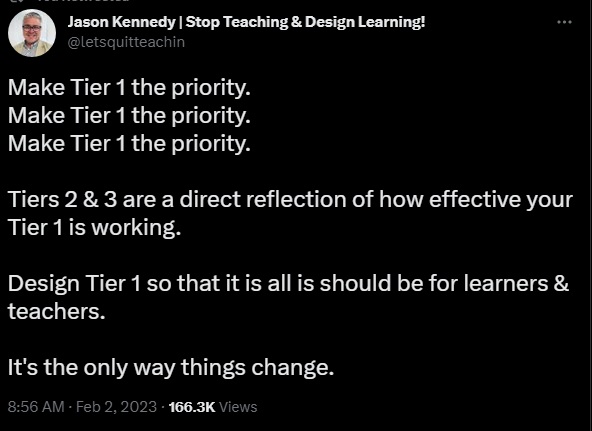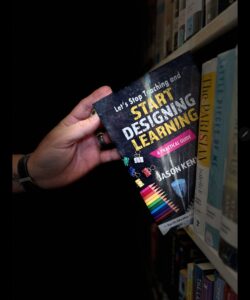Recently, I had a tweet get some attention. The post above seemed to resonate with many out there in the Twitterverse. What that says is this: We all know why it’s important. We all know it is what we ought to be doing in our schools. My question is then, what’s stopping us?
I can speak to my own personal journey as an educator. I went to college, learned a lot of content, and entered into a classroom and started teaching what I learned. Most of us experienced this same narrative. Now, I went to my room and made it my own. I knew the classes I didn’t enjoy in school and made every attempt to give my students a different experience. But what I missed out on (and what my eventual students missed out on as a result) in my formal education as a teacher was this: we weren’t taught anything about learning.
Yes, I had Educational Psychology and a few other courses that sprinkled in Blooms, Maslow, Piaget and some others. But I never had a single ounce of instruction in how learners learn or what things I needed to make a priority in my classroom to make learning happen. I was taught content and returned the favor to my students. This may be why some of us struggle with what Tier 1 really needs to be: we just didn’t know any better.
What we didn’t know is that the kids coming to us are not students to teach compliance and content to, they are learners to connect with and design learning for. That is the secret sauce of Tier 1. Relationships and Design. We need both if we want to really see a change in the learning in our schools and districts.
Let’s look at relationships first. We know that positive student-teacher relationships have an effect size of 0.62, or over a year’s worth of potential growth. What we also have to consider is the impact that relationships have on all the other things that have an impact. Students feeling accepted, students feeling liked, teacher credibility, teacher clarity, and many other things that bleed over into the effectiveness of our instruction take root in the relationships we nurture with our kids. Whether they are 8 or 18, they are kids. We have to choose to love them. That is a dedicated choice on our part. I love my 3 sons even though I may not like them all the time. But I choose to love them and choose to make sure they know that and that I have their backs. Our academic kids need us to make the same choice if we want to make Tier 1 the powerhouse it can be for learning.
The next thing we have to do after solidifying the relationship piece is to design learning for the kids we are choosing to love and give our best to in the classroom. We can just go in and teach, hoping things stick. We have to go find out what we missed out in some of our college courses about what affects learning. We have to know what evidence says works well, integrate it into our daily practice, and make it a part of the culture. We have to decide as a whole to be practitioners of the profession of education. That means we go to what research and evidence says works, apply it, examine the results, revise and refine, and continue to learn ourselves.
Collective teacher efficacy (effect size= 1.36 or 3+ years worth of potential growth) is about coming together as educators and stating, “Here are the practices that we collectively believe affects learning. Here is how we are dedicating these practices into our base Tier 1 instruction. Here is the evidence we see that shows that it is working.” Getting commitment to this, not buy-in, is necessary for this to be successful. Once we have that commitment, we go all in. We put our beliefs, backed by evidence, into practice. If we want it to work, it requires us to do these things well, consistently and over the long term. Effect sizes don’t matter otherwise.
What does this mean and how does it affect what we do in the classroom then for Tier 1? It means we have to give all our energy into design before we ever enter the classroom. There is a trade off and it is this: Giving that time and energy into the design can give you the time and energy you would be expending in the classroom with your learners. You will be the one with the energy to run down the hallway doing cartwheels at the end of the school day instead of our kids. Why? Because you will have designed their learning for them to engage with and tackle. They will be the ones who are accessing information, assessing their learning progress, seeking answers, collaborating, reflecting, revising, and so much more. You will be a facilitator of the learning you have carefully engineered for them. You will be turning learning back over to whom it belonged to all along: the learners. Design is the key.
So, like the tweet above says, Make Tier 1 the priority. Do this through a commitment to two things: relationships and design. Then, watch what happens to the need for Tiers 2 and 3 services.


